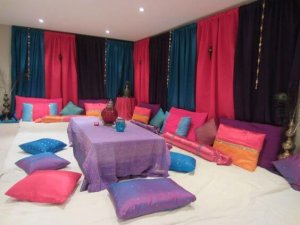5 Key Features of the Oriental Style

There are so many different possibilities when it comes to decorating our homes. But if you want to create an original and innovative look, here you’ll find 5 key features of the oriental style, a trend that’s been making waves in the world of interior design over the past few years.
As a general rule, people in western countries tend to use elements that are typical of traditional or classical western styles. We feel safer sticking with the looks we know best. Nowadays, however, more and more people are starting to try out modern and fusion decor in their homes, taking inspiration from all over the world.
The contemporary feel that characterizes oriental decor makes it particularly appealing to interior designers. As a result, Asian styles have become a reference point for designers everywhere, and are gaining more and more prominence in the western world.
1. Key features of the oriental style – floor-level seating

Floor-level seating is a common feature in many Asian countries. While you can also find raised seating and armchairs, the majority of people prefer to incorporate traditional floor seating. Some, such as the Japanese zaisu, even have backrests.
However, other types of oriental seating don’t have backrests at all, consisting only of a cushion or support. Sitting on cushions or even directly on the floor is a common practice in many Asian cultures.
In this regard, oriental culture is very different from western culture. Specialist home and decor stores offer a variety of different kinds of floor-seating, allowing you to recreate the oriental style in your own home. This is a really interesting way to give your home a different look.
The oriental style is no stranger to comfort.
2. Low coffee tables

Just like floor-level seating, low tables also form a key part of the oriental style. They’re typically used for eating or drinking tea. Because they’re so low to the ground, you need to sit down to use them comfortably.
The best option is to complement these low tables with traditional oriental floor seating. If you simply place one of these tables in the corner of the room, you run the risk of turning it into a purely decorative object.
3. Key features of the oriental style – flooring

In both Eastern and Muslim countries, floors are often covered in richly decorated rugs and matting which provide a sense of comfort and warmth. Let’s take a look at some of the most interesting options:
- Fine cotton rugs are perfect for creating comfortable flooring under our feet and will provide extra padding if you want to sit on the floor or meditate. They’ll also help to protect your parquet flooring from marks and scratches.
- Esparto grass rugs make fantastic decorative elements. They’re highly resistant to wear and tear and can support heavy pieces of furniture and other objects. They’re usually circular or rectangular and don’t take up too much space.
- Synthetic mats (as well as those made from other materials) are great for covering entire floors, especially when it comes to living rooms. Although many oriental homes are completely carpeted, we’d recommend leaving part of your parquet flooring visible.
4. Rice paper walls

While it’s very rare to find rice paper walls in typical western houses, they’re a common feature in many Asian homes. They’re designed to allow in plenty of light, while simultaneously filtering and softening it.
The walls are made of a metallic structure and can be slid back and forth to separate or unite rooms. The rice paper serves to provide a certain level of privacy in each of the rooms, without creating an entirely solid wall.
5. Key features of the oriental style – low lighting

As you’ve probably noticed in many Asian restaurants, the lighting is usually kept fairly low. They generally avoid intense lightbulbs that direct the light toward one specific point, as well as skylights that allow light to flood in.
Normally, rice paper lamps are used to filter the light and create a relaxing, calm and peaceful atmosphere. Spherical Chinese lamps are one of the most popular choices in Oriental decoration.
While they place great value on natural light, it must be filtered so that it’s not too harsh or direct. This is possibly the most important of these five key features of the oriental style.
All cited sources were thoroughly reviewed by our team to ensure their quality, reliability, currency, and validity. The bibliography of this article was considered reliable and of academic or scientific accuracy.
Gilliatt, Mary: El libro de decoración, Folio, 1987.








